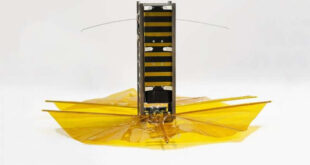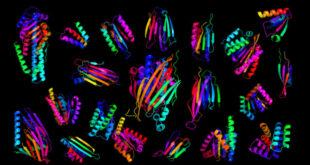Low doses of far ultraviolet C light can inactivate airborne influenza and other viruses without harming human tissues, according to a study published in the February 9, 2018 issue of the journal Scientific Reports.
Welch et al show for the first time that far-UVC efficiently inactivates airborne aerosolized viruses. These fluorescent images show epithelial cells infected with H1N1; the viruses were exposed in aerosolized form in the irradiation chamber to doses of 0, 0.8, 1.3 or 2.0 mJ/cm2 of 222-nm far-UVC light; infected cells fluoresce green. Image credit: Welch et al, doi: 10.1038/s41598-018-21058-w.
Researchers have known for decades that broad-spectrum ultraviolet C (UVC) light, which has a wavelength of between 200 to 400 nm, is highly effective at killing bacteria and viruses by destroying the molecular bonds that hold their DNA together. This conventional UV light is routinely used to decontaminate surgical equipment.
“Unfortunately, conventional germicidal UV light is also a human health hazard and can lead to skin cancer and cataracts, which prevents its use in public spaces,” said lead author Professor David Brenner, from the Center for Radiological Research at Columbia University Irving Medical Center.
Several years ago, Professor Brenner and co-authors hypothesized that a narrow spectrum of ultraviolet light called far-UVC (207-222?nm) could kill microbes without damaging healthy tissue.
“Far-UVC light has a very limited range and cannot penetrate through the outer dead-cell layer of human skin or the tear layer in the eye, so it’s not a human health hazard,” Professor Brenner said.
“But because viruses and bacteria are much smaller than human cells, far-UVC light can reach their DNA and kill them.”
In their earlier studies, Professor Brenner and colleagues demonstrated that far-UVC light was effective at killing methicillin-resistant Staphylococcus aureus bacteria, but without harming human or mouse skin.
Influenza virus spreads from person to person mainly through fine liquid droplets, or aerosols, that become airborne when people with flu cough, sneeze, or talk.
The new study was designed to test if far-UVC light could efficiently kill aerosolized influenza virus in the air, in a setting similar to a public space.
In the study, aerosolized influenza A virus (H1N1) was released into a test chamber and exposed to very low doses of 222 nm far-UVC light. A control group of aerosolized virus was not exposed to the UVC light.
The far-UVC light efficiently inactivated H1N1, with about the same efficiency as conventional germicidal UV light.
“If our results are confirmed in other settings, it follows that the use of overhead low-level far-UVC light in public locations would be a safe and efficient method for limiting the transmission and spread of airborne-mediated microbial diseases, such as influenza and tuberculosis,” Professor Brenner said.
_____
David Welch et al. 2018. Far-UVC light: A new tool to control the spread of airborne-mediated microbial diseases. Scientific Reports 8, article number: 2752; doi: 10.1038/s41598-018-21058-w
 #Bizwhiznetwork.com Innovation ΛI |Technology News
#Bizwhiznetwork.com Innovation ΛI |Technology News




